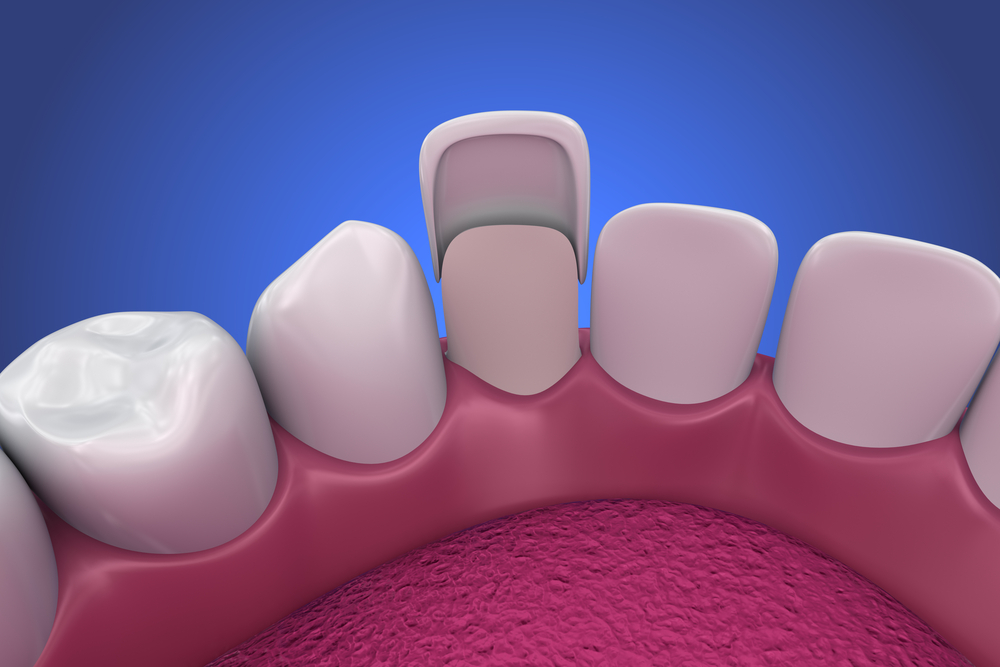In the 1990s, the phrase “cosmetic dentistry” was first used, and now it represents any dental procedure that enhances a person’s smile. White crowns and fillings, natural-looking replacement teeth, teeth whitening, cosmetic bonding and contouring, and Invisalign or ClearCorrect clear aligners are examples of cosmetic dental procedures. The most transformative, expedient cosmetic treatment, however, is porcelain veneers.
Veneers were first used in 1928, when Dr. Charles Pincus created them as part of an actor’s costume. In the 1950s, veneers won some popularity with image-conscious adults, but until the 1980s, veneers were only temporary restorations. Today, porcelain veneers are thin, durable, natural-looking, and permanent.
In a matter of only two appointments, a dentist can place custom-made porcelain veneers onto a patient’s front upper and lower teeth. The restorations improve the color, size, shape, alignment, spacing, and overall symmetry of a person’s smile, in a single treatment.
Benefits of Veneers
As an all-in-one cosmetic smile makeover, veneers provide the shortest treatment time and longest-lasting results of all esthetic dentistry. Benefits include:
- Only two visits to complete the procedure
- Can last up to 20 years or longer
- Thin, yet durable
- Reflect light like natural tooth enamel
- Resist most staining elements
- Cannot decay
- Replace the need for whitening, orthodontics, bonding, and contouring
- Care for them like you do your natural teeth
- Permanent
Longevity and Care
As mentioned, porcelain veneers can last 20 years or more. To extend the life of veneers, practice excellent oral hygiene at home and attend six-month checkups and cleanings. Avoid or limit staining elements like tobacco, coffee, tea, dark sauces, and red wine. Wear a mouth guard when playing sports, and refrain from chewing on anything but food. Don’t habitually nibble on your nails, pen caps, or ice.
To care for veneers, simply brush morning and evening, and floss before evening brushing. Use a tongue scraper and mouthwash to remove excess plaque and bacteria from your mouth, as well. Note that veneers cannot be whitened, so whitening strips, gels, rinses, and pastes will not lighten your veneers.
Natural tooth enamel stains more quickly and frequently than veneers, so whitening is a good choice in these circumstances. Your natural teeth should match the shade of your veneers, so they look totally natural.
Costs and Financing
Each veneer is hand-crafted by a dental ceramist using high-quality, layered dental porcelain. Because of the time and materials required to create veneers, they are not inexpensive. It’s important to consider how long they’ll last when deciding whether to invest in veneers. No other dental restoration or prosthetic lasts 20 years or more.
The exact price of your veneers will be based on factors like how many you need and the grade of materials used to make them. Dr. Brown will consult with you on these topics before developing your custom treatment plan. Then, we’ll discuss the cost and how you will pay for your smile-enhancing, life-changing porcelain veneers.
Since dental insurance does not cover cosmetic procedures, you may need to pay by credit card or through a third-party financing institution like CareCredit. This option offers low- and no-interest, monthly payment plans for qualifying applicants. We want to make a beautiful smile affordable for all of our patients.
Call for Your Veneers Consultation
Are you ready to learn more about cosmetic dentistry and porcelain veneers? Call Thomas F. Brown Family & Sedation Dentistry today at 630-369-3120 to schedule a consultation with Dr. Brown. Veneers can improve your smile, as well as your self-confidence and quality of life, so make your appointment today!

